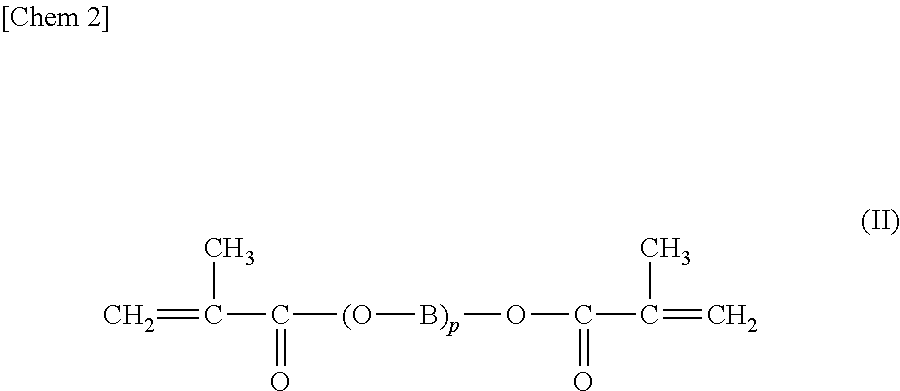Photochromic lens for eye glasses
a technology of photochromic compound and lens, applied in the field of photochromic can solve the problems of insufficient solubility of photochromic compound into the coating, limited material permeation of the lens base material, and inability to achieve satisfactory level as lens for eye glasses, etc., to achieve the effect of enhancing the solubility or dispersibility of photochromic compound, and reducing the thickness and weight of the lens
- Summary
- Abstract
- Description
- Claims
- Application Information
AI Technical Summary
Benefits of technology
Problems solved by technology
Method used
Image
Examples
example 1
[0089]In 100 parts by mass of a mixed solution of 50% by mass of 2,2′-bis[4-(methacryloyloxyethoxy)phenyl]propane (a compound where R1 is a methyl group, R2 is a hydrogen atom and m+n=2.3 in general formula (I)), 10% by mass of ethylene glycol dimethacrylate (p=3) and 40% by mass of divinylbenzene (purity 96%, total of this and an ethylvinylbenzene component is 99%), 0.02 parts by mass of Photochromic Dyes PH-4115 manufactured by Chromtech was dissolved as a photochromic compound, to which 1.0 part by mass of 2,4-diphenyl-4-methyl-1-pentene was added and mixed as a polymerization degree adjuster.
[0090]Next, the preparation obtained by the mixing was poured into two kinds of molds, each being made of 2 glass molds and a plastic gasket.
[0091]Furthermore, each mold was placed in a hot air circulation type heating furnace and heated at 40° C. for 12 hours. After that, the temperature was raised up to 85° C. over 4 hours and heating was performed for 2 hours, for polymerization.
[0092]Aft...
examples 2 and 3
[0105]In just the same way as that in Example 1, except for changing the value of 2,2′-bis[4-(methacryloyloxyethoxy)phenyl]propane of general formula (I) as shown in Table 1, photochromic lenses were fabricated.
[0106]These lenses were evaluated in the same way as that in Example 1, and as shown in Table 1, the results showed that these lenses had the same good performances as those in Example 1 and were able to be used favorably as a lens for eye glasses.
examples 4 to 7
[0107]In just the same way as that in Example 2, except for changing the value of p of polyethylene glycol dimethacrylate of general formula (II) as shown in Table 1, in place of triethylene glycol dimethacrylate, photochromic lenses were fabricated.
[0108]These lenses were evaluated in the way as that in Example 1, and as shown in Table 1, the results showed that lenses had the same good performances as those in Example 1 and were able to be used favorably as a lens for eye glasses.
PUM
| Property | Measurement | Unit |
|---|---|---|
| Fraction | aaaaa | aaaaa |
| Fraction | aaaaa | aaaaa |
| Percent by mass | aaaaa | aaaaa |
Abstract
Description
Claims
Application Information
 Login to View More
Login to View More - R&D
- Intellectual Property
- Life Sciences
- Materials
- Tech Scout
- Unparalleled Data Quality
- Higher Quality Content
- 60% Fewer Hallucinations
Browse by: Latest US Patents, China's latest patents, Technical Efficacy Thesaurus, Application Domain, Technology Topic, Popular Technical Reports.
© 2025 PatSnap. All rights reserved.Legal|Privacy policy|Modern Slavery Act Transparency Statement|Sitemap|About US| Contact US: help@patsnap.com



